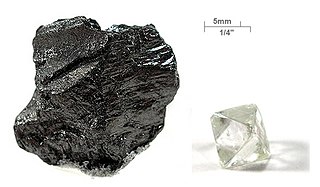
Carbon is a chemical element with the symbol C and atomic number 6. It is nonmetallic and tetravalent—its atom making four electrons available to form covalent chemical bonds. It belongs to group 14 of the periodic table. Carbon makes up about 0.025 percent of Earth's crust. Three isotopes occur naturally, 12C and 13C being stable, while 14C is a radionuclide, decaying with a half-life of about 5,730 years. Carbon is one of the few elements known since antiquity.
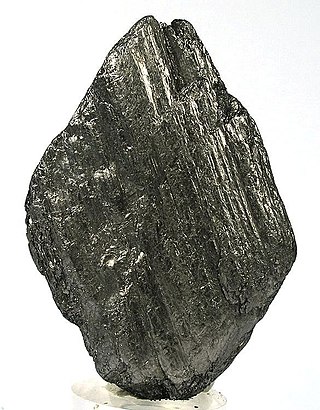
Graphite is a crystalline form of the element carbon. It consists of stacked layers of graphene. Graphite occurs naturally and is the most stable form of carbon under standard conditions. Synthetic and natural graphite are consumed on large scale for uses in pencils, lubricants, and electrodes. Under high pressures and temperatures it converts to diamond. It is a weak conductor of heat and electricity.

The Advanced Gas-cooled Reactor (AGR) is a type of nuclear reactor designed and operated in the United Kingdom. These are the second generation of British gas-cooled reactors, using graphite as the neutron moderator and carbon dioxide as coolant. They have been the backbone of the UK's nuclear power generation fleet since the 1980s.

The pebble-bed reactor (PBR) is a design for a graphite-moderated, gas-cooled nuclear reactor. It is a type of very-high-temperature reactor (VHTR), one of the six classes of nuclear reactors in the Generation IV initiative.

In nuclear engineering, a neutron moderator is a medium that reduces the speed of fast neutrons, ideally without capturing any, leaving them as thermal neutrons with only minimal (thermal) kinetic energy. These thermal neutrons are immensely more susceptible than fast neutrons to propagate a nuclear chain reaction of uranium-235 or other fissile isotope by colliding with their atomic nucleus.

The RBMK is a class of graphite-moderated nuclear power reactor designed and built by the Soviet Union. The name refers to its design where, instead of a large steel pressure vessel surrounding the entire core, the core is surrounded by a cylindrical annular steel tank inside a concrete vault and each fuel assembly is enclosed in an individual 8 cm (inner) diameter pipe. The channels also contain the coolant, and are surrounded by graphite.

Carbon is capable of forming many allotropes due to its valency. Well-known forms of carbon include diamond and graphite. In recent decades, many more allotropes have been discovered and researched, including ball shapes such as buckminsterfullerene and sheets such as graphene. Larger-scale structures of carbon include nanotubes, nanobuds and nanoribbons. Other unusual forms of carbon exist at very high temperatures or extreme pressures. Around 500 hypothetical 3‑periodic allotropes of carbon are known at the present time, according to the Samara Carbon Allotrope Database (SACADA).

Chicago Pile-1 (CP-1) was the world's first artificial nuclear reactor. On 2 December 1942, the first human-made self-sustaining nuclear chain reaction was initiated in CP-1, during an experiment led by Enrico Fermi. The secret development of the reactor was the first major technical achievement for the Manhattan Project, the Allied effort to create atomic bombs during World War II. Developed by the Metallurgical Laboratory at the University of Chicago, CP-1 was built under the west viewing stands of the original Stagg Field. Although the project's civilian and military leaders had misgivings about the possibility of a disastrous runaway reaction, they trusted Fermi's safety calculations and decided they could carry out the experiment in a densely populated area. Fermi described the reactor as "a crude pile of black bricks and wooden timbers".

The Lucens reactor was a 6 MW experimental nuclear power reactor built next to Lucens, Vaud, Switzerland. After its connection to the electrical grid on 29 January 1968, the reactor only operated for a few months before it suffered an accident on 21 January 1969. The cause was a corrosion-induced loss of heat dispersal leading to the destruction of a pressure tube which caused an adjacent pressure tube to fail, and partial meltdown of the core, resulting in radioactive contamination of the cavern.
Graphite is a programmable Unicode-compliant smart font technology and rendering system developed by SIL International as free software, distributed under the terms of the GNU Lesser General Public License and the Common Public License.

A high-temperature gas-cooled reactor (HTGR), is a nuclear reactor that uses a graphite moderator with a once-through uranium fuel cycle. The HTGR is a type of high-temperature reactor (HTR) that can conceptually have an outlet temperature of 750 °C (1,380 °F). The reactor core can be either a "prismatic block" or a "pebble-bed" core. The high temperatures enable applications such as process heat or hydrogen production via the thermochemical sulfur–iodine cycle.

A nuclear reactor core is the portion of a nuclear reactor containing the nuclear fuel components where the nuclear reactions take place and the heat is generated. Typically, the fuel will be low-enriched uranium contained in thousands of individual fuel pins. The core also contains structural components, the means to both moderate the neutrons and control the reaction, and the means to transfer the heat from the fuel to where it is required, outside the core.

The Boudouard reaction, named after Octave Leopold Boudouard, is the redox reaction of a chemical equilibrium mixture of carbon monoxide and carbon dioxide at a given temperature. It is the disproportionation of carbon monoxide into carbon dioxide and graphite or its reverse:
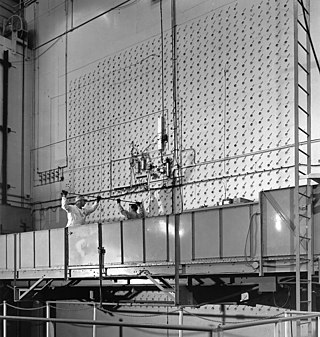
The X-10 Graphite Reactor is a decommissioned nuclear reactor at Oak Ridge National Laboratory in Oak Ridge, Tennessee. Formerly known as the Clinton Pile and X-10 Pile, it was the world's second artificial nuclear reactor, and the first designed and built for continuous operation. It was built during World War II as part of the Manhattan Project.
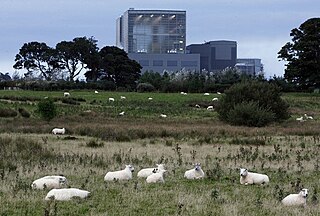
Hunterston B nuclear power station is a shut down AGR nuclear power station in North Ayrshire, Scotland. Located about 6 miles (9.7 km) south of Largs and about 2.5 miles (4.0 km) north-west of West Kilbride on the Firth of Clyde coast. It is currently operated by EDF Energy, and began producing electricity in 1976. The station ceased generation on 7 January 2022. On 19 May 2022, EDF announced that defueling was started on the two Hunterston B units. This process is expected to take over three years to complete, and it involves the complete emptying of all fuel channels from both reactors. This amounts to over 300 channels from each reactor, each containing 8 fuel elements. Fully loaded flasks containing the used fuel are scheduled to be dispatched from the site by rail to Sellafield at a maximum rate of three per week.
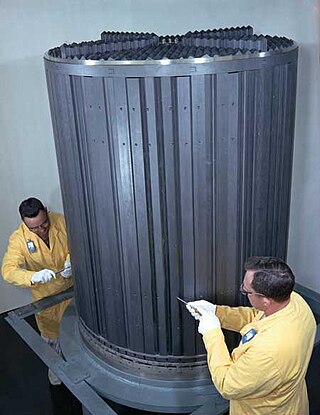
Nuclear graphite is any grade of graphite, usually synthetic graphite, manufactured for use as a moderator or reflector within a nuclear reactor. Graphite is an important material for the construction of both historical and modern nuclear reactors, due to its extreme purity and ability to withstand extremely high temperature. Graphite has also recently been used in nuclear fusion reactors such as the Wendelstein 7-X. As of experiments published in 2019, graphite in elements of the stellarator's wall and a graphite island divertor have greatly improved plasma performance within the device, yielding better control over impurity and heat exhaust, and long high-density discharges.
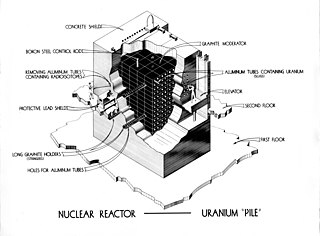
A graphite-moderated reactor is a nuclear reactor that uses carbon as a neutron moderator, which allows natural uranium to be used as nuclear fuel.
A gas-cooled reactor (GCR) is a nuclear reactor that uses graphite as a neutron moderator and a gas as coolant. Although there are many other types of reactor cooled by gas, the terms GCR and to a lesser extent gas cooled reactor are particularly used to refer to this type of reactor.

Tokai Carbon Co., Ltd. is a Japanese company. The company is a developer and stockist of graphite material for use in nuclear power, particularly electrical discharge machining electrode, high temperature, and mechanical applications.

TMSR-LF1 is a 2 MWt molten salt reactor (MSR) pilot plant located in northwest China.

















